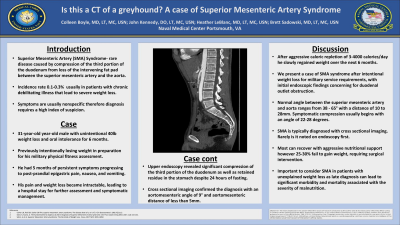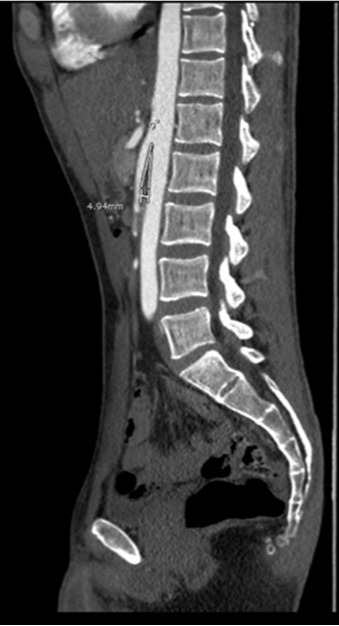Back


Poster Session D - Tuesday Morning
Category: Small Intestine
D0648 - CT of a Greyhound? A Case of Superior Mesenteric Artery Syndrome
Tuesday, October 25, 2022
10:00 AM – 12:00 PM ET
Location: Crown Ballroom

Has Audio

Colleen Boyle, MD
Naval Medical Center Portsmouth
Portsmouth, VA
Presenting Author(s)
Colleen Boyle, MD, John Kennedy, MD, Heather LeBlanc, MD, Brett Sadowski, MD
Naval Medical Center Portsmouth, Portsmouth, VA
Introduction: Superior Mesenteric Artery Syndrome (SMA) is a rare disease defined by compression of the duodenum due to loss of the intervening fat pad between the superior mesenteric artery and aorta leading to nausea, vomiting, and abdominal pain. Diagnosis requires a high index of suspicion as late diagnosis can lead to significant morbidity and mortality.
Case Description/Methods: A 31 year old active duty male presented with unintentional weight loss of 40 pounds and progressive oral intolerance for 6 months. Prior to his more precipitous weight loss, he had intentionally been losing weight in preparation for his military physical fitness assessment. After achieving his target weight, he noted continued weight loss. For 5 months his symptoms persisted and expanded to include post-prandial epigastric pain, nausea, and vomiting resulting in a hospital stay for intractable symptoms. Upper endoscopy performed revealed significant compression of the third portion of the duodenum and retained residue in the stomach despite 24 hours of fasting. Subsequent cross sectional imaging showed an aortomesenteric angle of 9 degrees with a distance of less than 5mm. He was referred to nutrition for conservative management with aggressive caloric repletion of 3-4000 calories/day, slowly regaining weight over the next 6 months.
Discussion: We present a case of SMA syndrome which developed after intentional weight loss for military service requirements, with endoscopic findings concerning for duodenal outlet obstruction. SMA is an rare diagnosis with incidence reports at 0.1-0.3%. Patients most at risk of developing SMA syndrome typically have chronic debilitating illnesses that lead to severe weight loss. The normal angle between the superior mesenteric artery and aorta ranges from 38 to 65 degrees with a distance of 10 to 28mm. Symptoms typically begin with an aortomesenteric angle of 22-28 degrees and distance of < 8mm. Most patients can recover with aggressive nutritional support however 25-30% fail to gain weight in the first 6 weeks, requiring surgical intervention. This case illustrates that even otherwise healthy patients who make efforts at rapid weight loss can be at risk of this rare condition and highlights the importance of maintaining a high index of suspicion in patients with unexplained weight loss as the symptoms are non-specific. For this patient, not only was the presenting weight loss abnormal but the severity of the angle to less than 9 was significant and notable.

Disclosures:
Colleen Boyle, MD, John Kennedy, MD, Heather LeBlanc, MD, Brett Sadowski, MD. D0648 - CT of a Greyhound? A Case of Superior Mesenteric Artery Syndrome, ACG 2022 Annual Scientific Meeting Abstracts. Charlotte, NC: American College of Gastroenterology.
Naval Medical Center Portsmouth, Portsmouth, VA
Introduction: Superior Mesenteric Artery Syndrome (SMA) is a rare disease defined by compression of the duodenum due to loss of the intervening fat pad between the superior mesenteric artery and aorta leading to nausea, vomiting, and abdominal pain. Diagnosis requires a high index of suspicion as late diagnosis can lead to significant morbidity and mortality.
Case Description/Methods: A 31 year old active duty male presented with unintentional weight loss of 40 pounds and progressive oral intolerance for 6 months. Prior to his more precipitous weight loss, he had intentionally been losing weight in preparation for his military physical fitness assessment. After achieving his target weight, he noted continued weight loss. For 5 months his symptoms persisted and expanded to include post-prandial epigastric pain, nausea, and vomiting resulting in a hospital stay for intractable symptoms. Upper endoscopy performed revealed significant compression of the third portion of the duodenum and retained residue in the stomach despite 24 hours of fasting. Subsequent cross sectional imaging showed an aortomesenteric angle of 9 degrees with a distance of less than 5mm. He was referred to nutrition for conservative management with aggressive caloric repletion of 3-4000 calories/day, slowly regaining weight over the next 6 months.
Discussion: We present a case of SMA syndrome which developed after intentional weight loss for military service requirements, with endoscopic findings concerning for duodenal outlet obstruction. SMA is an rare diagnosis with incidence reports at 0.1-0.3%. Patients most at risk of developing SMA syndrome typically have chronic debilitating illnesses that lead to severe weight loss. The normal angle between the superior mesenteric artery and aorta ranges from 38 to 65 degrees with a distance of 10 to 28mm. Symptoms typically begin with an aortomesenteric angle of 22-28 degrees and distance of < 8mm. Most patients can recover with aggressive nutritional support however 25-30% fail to gain weight in the first 6 weeks, requiring surgical intervention. This case illustrates that even otherwise healthy patients who make efforts at rapid weight loss can be at risk of this rare condition and highlights the importance of maintaining a high index of suspicion in patients with unexplained weight loss as the symptoms are non-specific. For this patient, not only was the presenting weight loss abnormal but the severity of the angle to less than 9 was significant and notable.

Figure: Abdominal CT providing diagnosis of SMA
Disclosures:
Colleen Boyle indicated no relevant financial relationships.
John Kennedy indicated no relevant financial relationships.
Heather LeBlanc indicated no relevant financial relationships.
Brett Sadowski indicated no relevant financial relationships.
Colleen Boyle, MD, John Kennedy, MD, Heather LeBlanc, MD, Brett Sadowski, MD. D0648 - CT of a Greyhound? A Case of Superior Mesenteric Artery Syndrome, ACG 2022 Annual Scientific Meeting Abstracts. Charlotte, NC: American College of Gastroenterology.
